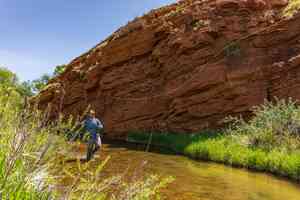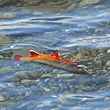In the backwater sloughs and bays of southern Idaho’s Snake River, June is prime time for the carp spawn.
The big invasives, brought here more than a century ago as a food fish from southern Asia (and rarely eaten) start to move into the shallows when Mother Nature strings a few nice days together in April or early May. Some fish will spawn during these first few weeks, but, for the most part, they’re staging. And they’re eating.
As warmer weather--and warmer water--sets in, the big females (females are usually bigger than males) start to move onto the flats in earnest. This is when, as a wading angler, you’ll see one big fish (the female) cruising the shallows, often trailed by two or more smaller carp (the males). The smaller carp will try to bump into the female in hopes of getting her to spill eggs so that they can fertilize them. This is, generally, how carp spawn. They don’t make redds. They’re broadcast spawners, meaning the milt from several males can fertilize the eggs of several females.
It’s a carp orgy.
Catching fish that are really into spawning is tough to do. But, as the spawn progresses into June, there are really good opportunities to sight-fish to carp that are either post-spawn, or simply taking a smoke break from all the gluttonous cyprinid sex. In shallow water, these fish are easy to identify, simply because they’re not frolicking around in masses of free love, but rather tailing lazily and clearly on the prowl for food.
Here’s how to identify your targets when the flats are all stirred up during the spawn.
Masses of frolicking fish
When you see several fish rolling and breaching and generally bumping into one another, know that these fish are actively spawning. You can sure cast to them, but you best bet at a hookup is likely a snag. My advice? Don’t bother.
Cruising carp
Often, pairs or threesomes of spawning fish will break off from the orgy and slowly move away from the larger mass of fish. These fish can be targeted, and they will occasionally eat, but they’re not in food mode just yet. I honestly believe these are fish that might be a bit exhausted from the constant spawning and are just recovering. Wading anglers will notice that these fish, when they’re spooked, will tear through a pod of carp and cause panic throughout. Advice? Cast in front, much like you would with a bonefish or a redfish, but don’t get your hopes up.
Tailing carp
These are the players. They’re not actively spawning, and you can tell this by their slow rolls or the fact that their tails are waiving lazily in the breeze when their noses and barbels are sifting through the muck on the bottom. Often, they’ll group together, and you’ll see several tailing carp working in concert. These fish deserve a cast and a slow strip of whatever you’ve got on the end of your tippet. Be stealthy and try not line these fish--the can be very spooky.
The flies
This is one of carp fishing’s great mysteries. What do they eat? The answer is simple. Everything. But not everything all the time. Here on the Snake, the season starts with big dragonfly and damselfly nymphs--this is what’s in the water when the fish are first coming in, and I would wager that’s a pretty common food source early in the season, wherever carp move into the shallows to spawn. Imitations include traditional wet flies, like the Stayner Ducktail or an olive Rio Grande King. Even a small olive Woolly Bugger is a serviceable fly for these swimming nymphs.
As the water warms up, we tend to see more crawfish, and this is when it gets fun on the flats. Hungry carp will move out of their way to go after crawfish. And, often, the carp share the water with hungry smallmouth bass, so sometimes, blind-casting to carp using crawfish patterns can result in a surprise hookup with a lively smallie that’s likely trying to defend its redd. Any traditional crawfish patterns should work well, from olive to brown and even purple.
These backwaters are also home to leeches and worms, so I often default to a dark ‘Bugger, which could be a leech or crawfish--it’s easily my most effective pattern for Snake River Carp.
The approach
If you’ve walked and waded for bonefish or permit, you’re equipped to wade for carp. Slow and deliberate. Don’t move too much water. As a great bonefish guide once told me in the Bahamas, “If you can hear the water moving around your legs when you walk, you’re walking too fast.”
Carp are smart--perhaps the smartest freshwater fish most of us will ever encounter. They can sense movement, and it often seems like they know you’re there, even when you’re taking every precaution. And, when you spook one, they’ll blister through a pod and alert every single fish, and they’ll spook, too. Carp give off pheromones when they panic, so when one fish spooks, you’ll see dozens of fish spooking in their wake.
The set
Last week, I shared one of my favorite carp locations with a fellow fly-fishing friend of mine, and he hit the river, eager connect to a big behemoth and see what it’s like to watch his tippet knot click through the snake guides on his 8-weight. The results?
“I missed three and hooked one, but I lost it.”
I’ve been chasing these fish for 20 years, and sometimes it’s easy to forget that they do require very specialized equipment (seriously, pretend you’re on a bonefish trip) and some specific skills that a lot of trout anglers don’t intuitively possess. The most important? Don’t trout set these fish. Strip set. Just like you would if you were casting to anything salty.
My buddy hadn’t gone after carp before and didn’t know what to expect. I kind of kicked myself for not helping him shorten the learning curve just a bit by mentioning that strip-setting on carp is absolutely vital.
Final word
Carp are one of the most challenging fish fly rodders can target in fresh water. While they may lack the sex appeal of trout or even bass, they make up for it line-peeling runs that will, quite often, make you think back to when you tied your backing knot, and have you hoping you did a good job. Don’t be intimidated or discouraged by tough outings for carp--sometimes, you can be surrounded by them all day long and never earn a bite. In time, you’ll one day figure out the right ingredients to a great carp outing--good weather, warm water, ample food and willing fish. We’re not always in control of all of these elements, but when it all comes together, you’ll become like a lot of us--carp junkies who, when we can’t make a run to the Caribbean, will make a run to the river for the next best thing.






























Comments